Kingston SSDNow V+100 Review
by Anand Lal Shimpi on November 11, 2010 3:05 AM EST- Posted in
- Storage
- SSDs
- Kingston
- SSDNow V+100
Overall System Performance using PCMark Vantage
Next up is PCMark Vantage, another system-wide performance suite. For those of you who aren’t familiar with PCMark Vantage, it ends up being the most real-world-like hard drive test I can come up with. It runs things like application launches, file searches, web browsing, contacts searching, video playback, photo editing and other completely mundane but real-world tasks. I’ve described the benchmark in great detail before but if you’d like to read up on what it does in particular, take a look at Futuremark’s whitepaper on the benchmark; it’s not perfect, but it’s good enough to be a member of a comprehensive storage benchmark suite. Any performance impacts here would most likely be reflected in the real world.
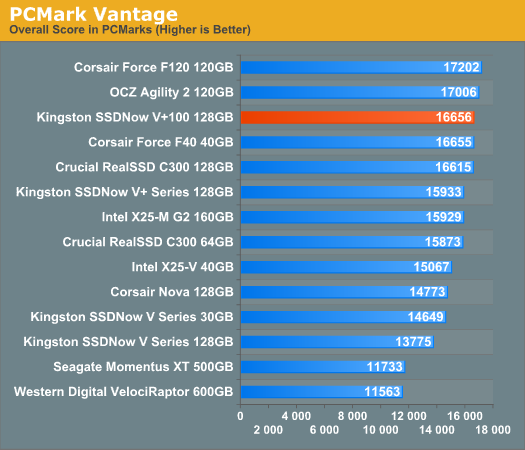
The SSDNow V+100 does very well here. Overall performance is in the top 3, higher than we’ve ever seen Kingston reach. In fact throughout the PCMark Vantage suite you'll see the SSDNow V+100 do very well. In some areas it's the fastest drive of the bunch (by a hair), while in others it's more of an average performer.
The Corsair Force F40 is the highest performing low capacity drive as you'd expect, beating out even the Intel X25-M G2. The 64GB C300 isn't too far behind however.
The memories suite includes a test involving importing pictures into Windows Photo Gallery and editing them, a fairly benign task that easily falls into the category of being very influenced by disk performance.
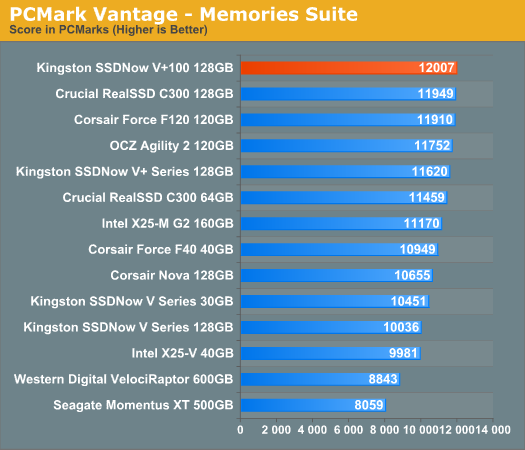
The TV and Movies tests focus on on video transcoding which is mostly CPU bound, but one of the tests involves Windows Media Center which tends to be disk bound.
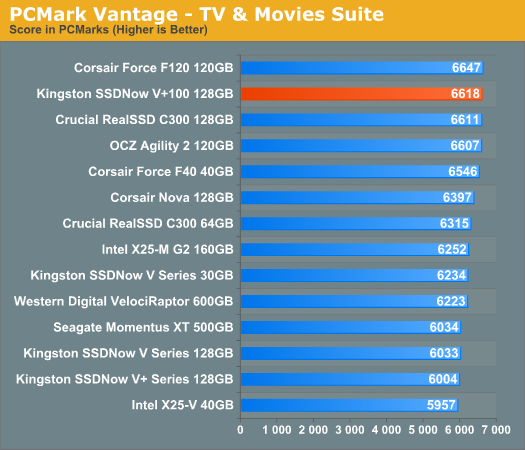
The gaming tests are very well suited to SSDs since they spend a good portion of their time focusing on reading textures and loading level data. All of the SSDs dominate here, but as you'll see later on in my gaming tests the benefits of an SSD really vary depending on the game. Take these results as a best case scenario of what can happen, not the norm.
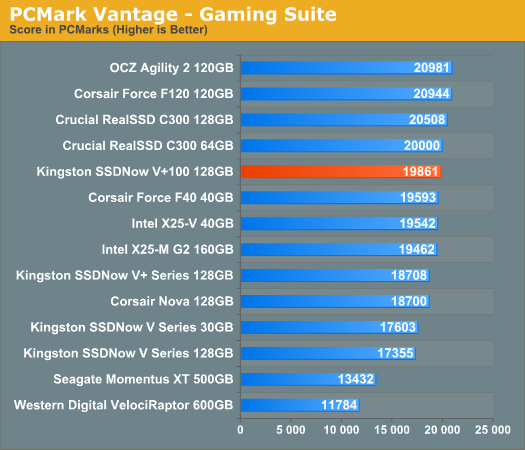
In the Music suite the main test is a multitasking scenario: the test simulates surfing the web in IE7, transcoding an audio file and adding music to Windows Media Player (the most disk intensive portion of the test).

The Communications suite is made up of two tests, both involving light multitasking. The first test simulates data encryption/decryption while running message rules in Windows Mail. The second test simulates web surfing (including opening/closing tabs) in IE7, data decryption and running Windows Defender.
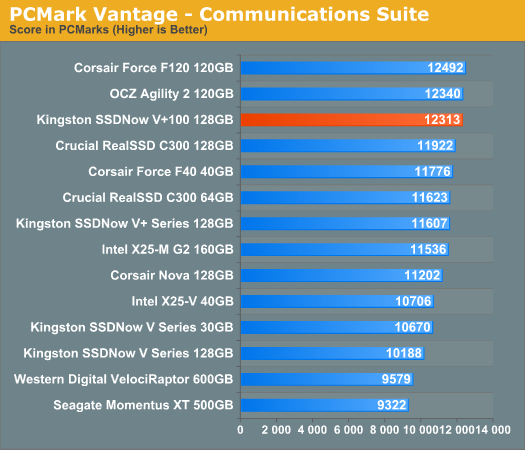
I love PCMark's Productivity test; in this test there are four tasks going on at once, searching through Windows contacts, searching through Windows Mail, browsing multiple webpages in IE7 and loading applications. This is as real world of a scenario as you get and it happens to be representative of one of the most frustrating HDD usage models - trying to do multiple things at once. There's nothing more annoying than trying to launch a simple application while you're doing other things in the background and have the load take forever.
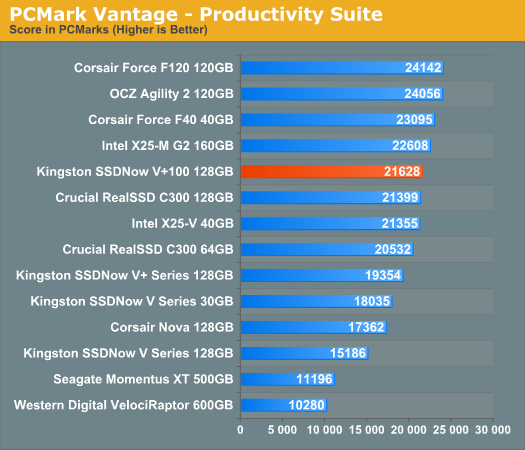
The final PCMark Vantage suite is HDD specific and this is where you'll see the biggest differences between the drives:
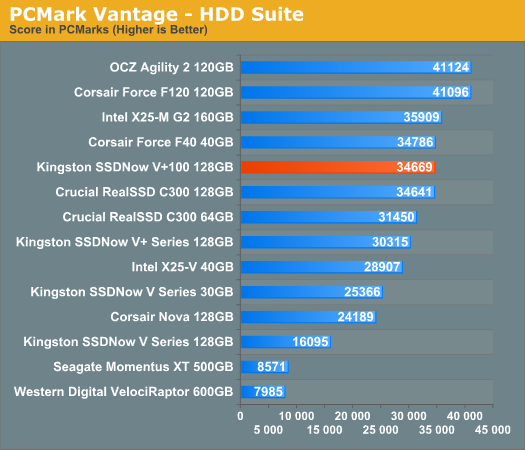
For pure I/O the SSDNow V+100 is good but not the best. Overall performance, as we've seen above looks to be pretty decent however. Let's keep going.










96 Comments
View All Comments
Ezekeel - Thursday, December 9, 2010 - link
That is all you have to do to enable TRIM, yes.However, I was talking about optimizations for an SSD (https://wiki.archlinux.org/index.php/SSD#Tips_for_... http://cptl.org/wp/index.php/2010/03/30/tuning-sol... which you all have to do manually while Windows7 afaik does at least some optimizations automatically if you install it on an SSD, like disabling (Super)PreFetch and indexing. Also partition setup with diskpart under Windows automatically takes care of a proper partition alignment while you still have to do it manually under Linux (http://randomtechoutburst.blogspot.com/2010/03/4k-...
ClagMaster - Monday, November 15, 2010 - link
You are right Mr Shimpi that this is confusing and I got a headache.I am not certain what I am going to get if I order a Kingston Drive. Performance is so diverse and the model nomenclature so similar.
I am going to get a OCZVertex 2 or an Intel X-25 G2 instead. I know what I am getting with these brands.
psyside1 - Sunday, November 21, 2010 - link
Hi Anand and all who read this.
Let me start of by saying that i'm new to SSD tech (noob) and i'm starting to learning but there are some things which where not pointed in the reviews as far as i remember.
Heck, even in this review you said that Inferno is somewhat capped to 50 mb/s if i'm not wrong?
So in short,
Where i live i'm limited to 2 models, one is Patriot Inferno and the Other A-DATA S599 with possibly 50K IOPS firmware, as Newegg and Amazon specs confirm?
Now, does that firmware insure i won't get slowdowns (at some points) like the Inferno model in this review? or there is some more about it. if there is, i really got no idea how is that possible same controller, same build? and heck in most of the test the Vertex 2 is still fastest, even faster then the other drives which now share the 50K IOPS firmware, G.Skill Phoenix pro, Corsair Force etc??
i'm mostly interested in SSD which will have good read/write speeds (4K etc) and to be fast during programs/games installation. I got 6 pcs connected in network so that means alot to me, in short does my needs require higher IOPS firmware or i would not notice any difference in performance during installation of big size programs/games.
Also, is it possible to know what revision you get without actually buying the product? is there any info on the package/sticker or part number? the difference in performance i noticed in some reviews was 2x higher random write (4K) speed on the models with OCZ "exclusive firmware. And as far that point goes i'm totally clueless does it really matter at all, and if its not how that that translate in real world usage?
Please answer i don't want to regret my purchase :(
Thanks and sorry for slight off topic :)
psyside1 - Sunday, November 21, 2010 - link
Sorry for double post there is no edit option, actually Madman007 was asking the same i did on the more appropriate way, my English is bad.
tno - Sunday, May 1, 2011 - link
"Remember that NAND is written to at the page level (4KB), but erased at the block level (512 pages)." I think you meant '512 KB.'Gaucherre - Friday, May 6, 2011 - link
Instead of $259, the Kingston V100+ 96GB is available for $119.99 after rebate from Buy.com. This pricing completely changes the value rating from acceptable to outstanding value! The mail-in rebate is rotating from one online store to another. Last month it was at Newegg.com; right now it's at Buy.com. Next month - who knows? Anyway, the cost per Gigabyte when tested here at Anandtech.com was around $2.70. Now it's $1.25 per Gigabyte, and a 96GB drive is large enough for Windows plus quite a few installed programs and games. Pretty good value. Think I just talked myself into ordering one .......